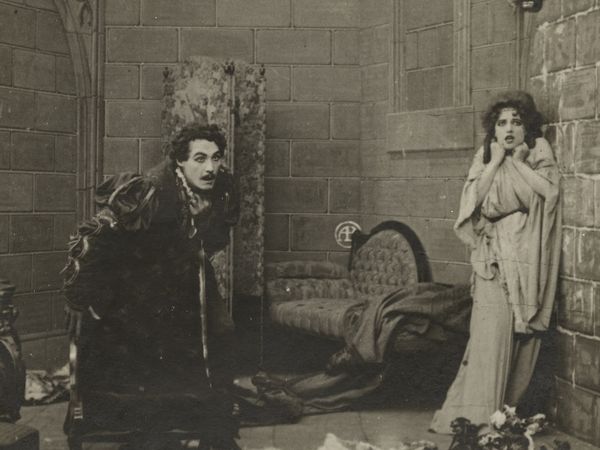THE SEALED ROOM
(La secuestración de dos enamorados)
D. W. Griffith (US 1909)
The first English translation of “La Grande Bretèche” appeared in 1835 in The London Keepsake under the title “The Deserted Chateau,” and was reproduced the same year in several U.S. periodicals (only in 1843 was it translated as a work of Balzac’s). Like all the silent film adaptations, this version did away with the first-person narration of Dr. Horace Bianchon, jumping right into the story of the abandoned mansion and its dark secret. Those only partly familiar with Balzac’s extraordinarily rich imagination might be surprised at so macabre a tale, yet its expert characterizations, elegantly and succinctly delineated with no moral judgment, fit very much into the author’s world view. To modern readers, Balzac’s refusal to condemn feels revolutionary, yet this was the quality that made many Victorians deeply uncomfortable, such as Margaret Fuller, writing in 1845, “he has no hatred for what is loathsome, no contempt for what is base, no love for what is lovely, no faith in what is noble. To him there is no virtue and no vice.”
Unsurprisingly, the filmmakers of 1909 felt a need to punish wayward behavior, which no doubt is why the Countess in Spergiura! is so flagrantly faithless, whereas in the short story she’s far more sympathetic. The same can be said for D. W. Griffith’s The Sealed Room, in which the King’s beloved (Marion Leonard) can’t wait to two-time His Majesty with an Italian troubadour (Henry B. Walthall). Another significant change is that both parties of the illicit couple are walled in, rather than just the male lover. Biograph’s version of the short story is considerably more static than Ambrosio’s, shot entirely in interiors and lacking the Italian film’s more dramatic cross-cutting techniques (André Gaudreault’s shot-by-shot study in The Griffith Project. 1909 is the definitive analysis). Both Arthur Johnson, as the King, and Marion Leonard indulge in exaggerated arm gestures, but there’s a truly unsettling moment when the troubadour, realizing they’ve been immured, desperately flails at the walls while the King’s beloved stands in the center of the room, frozen with panic. Linda Arvidson wrote that this was the film that “put Mr. Walthall over in the movies.”
A glowing review in Moving Picture World (18 September 1909) singled out the scene of the trapped lovers: “One’s nerves are strung almost to the breaking point under the strain. And when it is over and the picture disappears there is a relaxation which is difficult to describe, but is a great relief… In some respects this is probably the best film the Biograph people have ever sent out.” No doubt Vitagraph had gotten wind of the enticing subject matter, because in October they released their own version, Entombed Alive, most likely directed by Luigi Albertieri. In neither film’s publicity was Balzac’s name mentioned, but Variety’s “Rush” (Alfred Greason), mistakenly reviewing the Vitagraph as Buried Alive, remarked on the similarities: “If this is not a complete steal from the Biograph subject ‘The Sealed Room,’ it is a remarkable coincidence.”
Jay Weissberg

regia/dir: D. W. Griffith.
scen: ?, dal racconto di/based on a short story by Honoré de Balzac (“La Grande Bretèche”, 1831).
photog: G. W. Bitzer.
cast: Arthur Johnson (il re/the King), Marion Leonard (la sua favorita/his favored one), Henry B. Walthall (un trovatore italiano/an Italian troubadour), Mary Pickford, Gertrude Robinson, Linda Arvidson (dame di corte/ladies at court), George Siegmann, Owen Moore, William J. Butler, Verner Clarges (nobili di corte/noblemen at Court), George O. Nicholls, Anthony O’Sullivan (operai/workmen), Mack Sennett (un soldato/a soldier).
prod, dist: Biograph.
uscita/rel: 02.09.1909.
copia/copy: DCP, 11′; did./titles: SPA.
fonte/source: La Cineteca del Friuli, Gemona.


 Italiano
Italiano